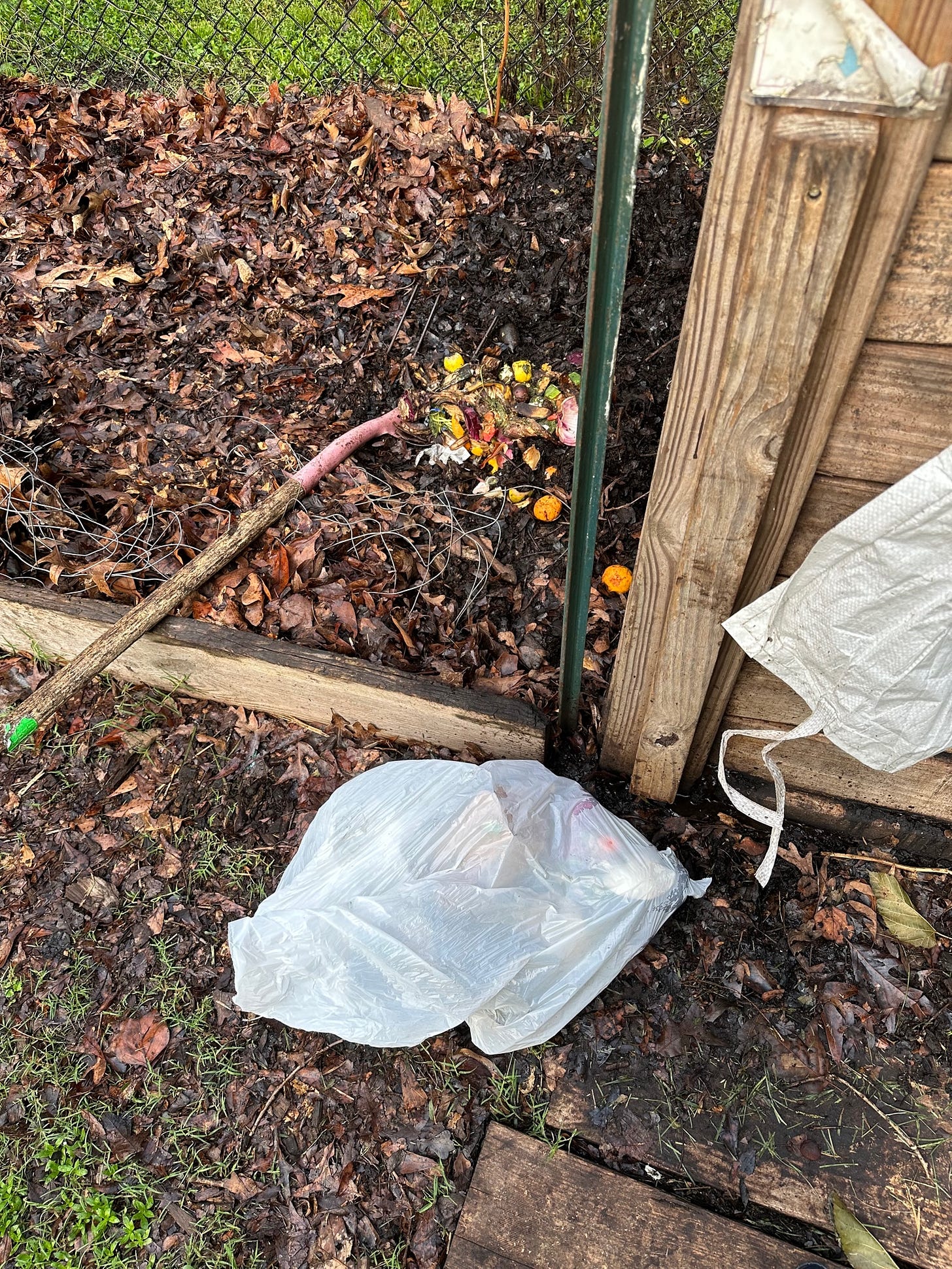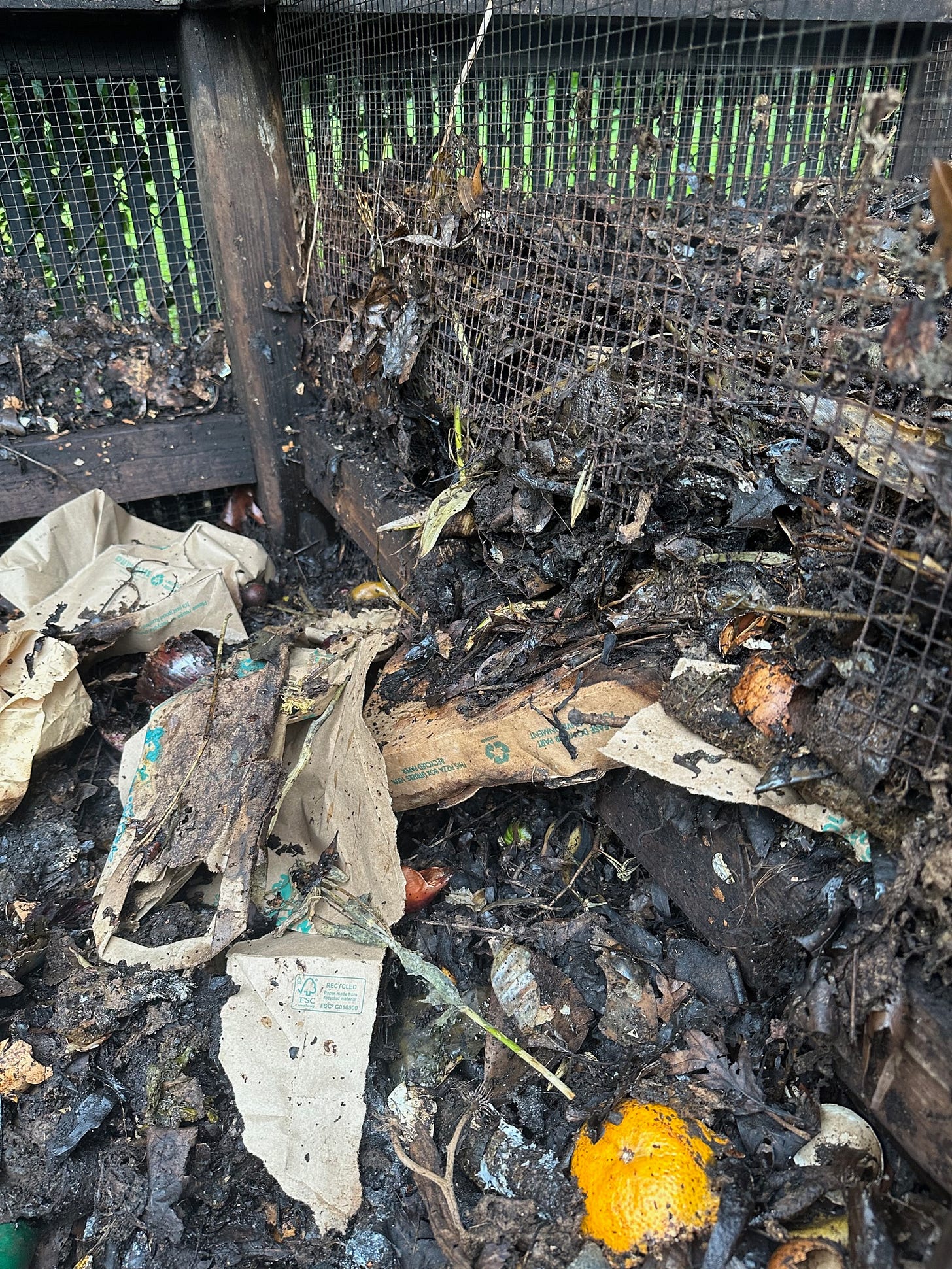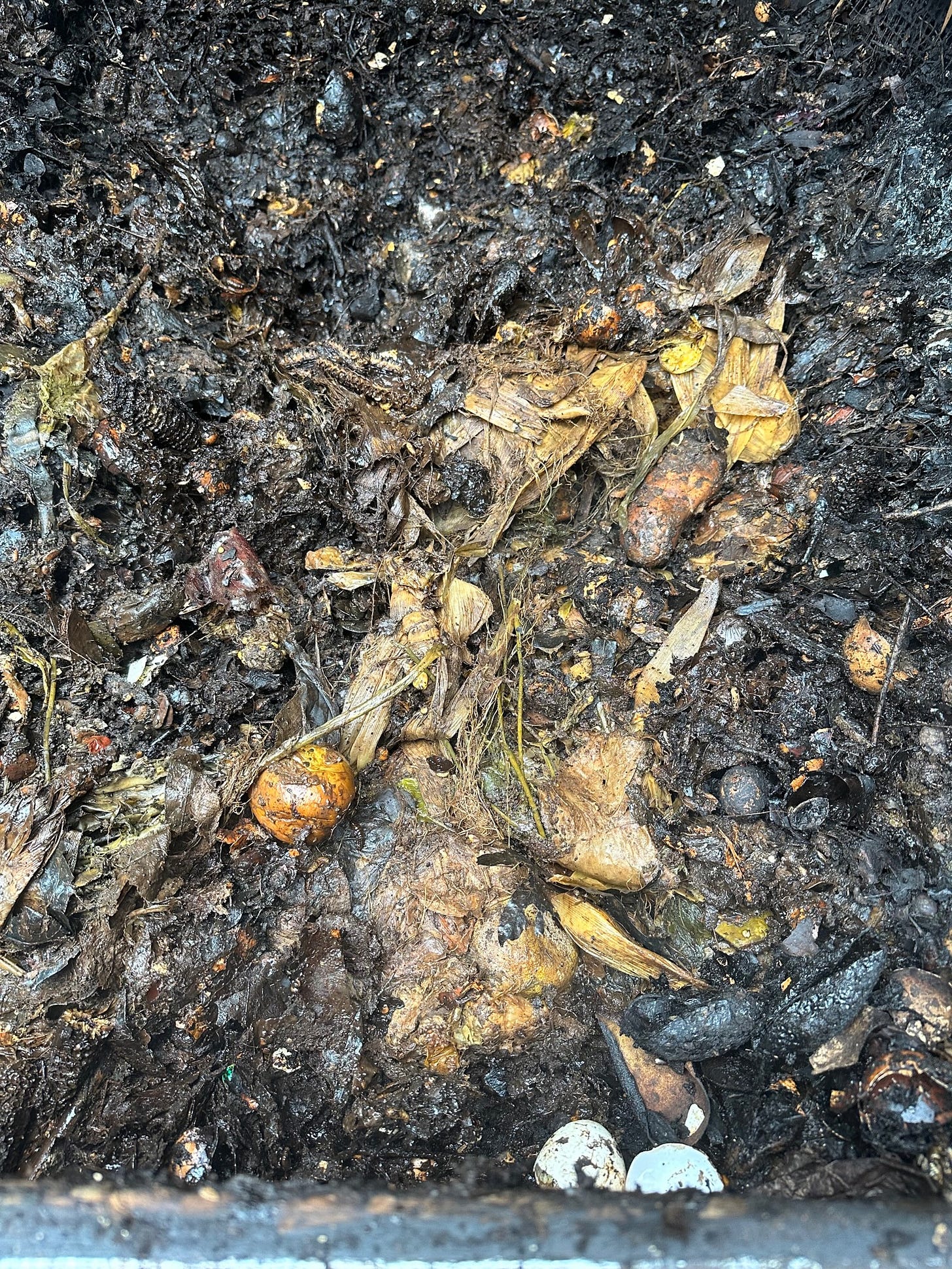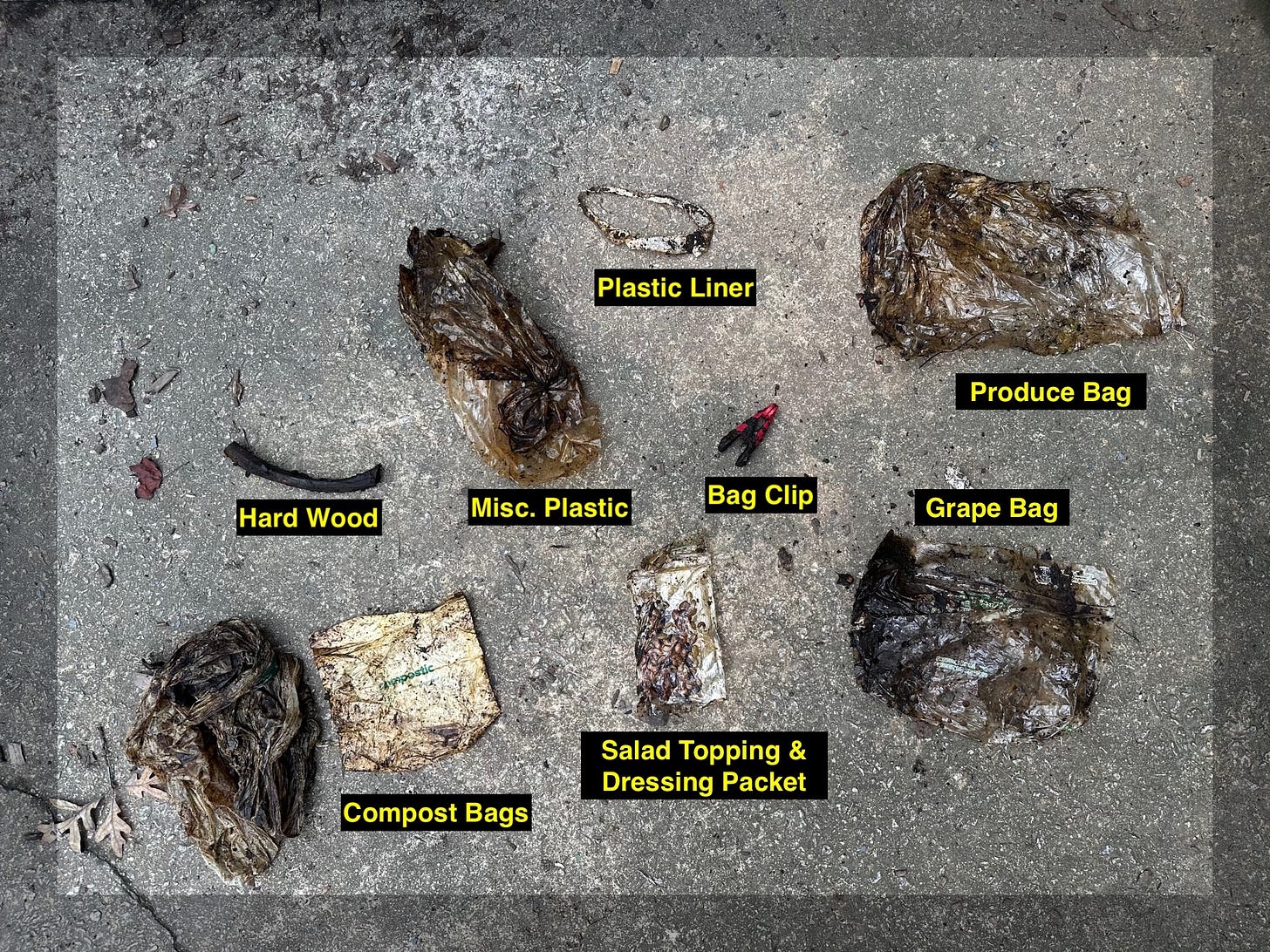Soundtrack: The Love Album
Hello Compost Fam! We have had a couple of new subscribers during my unannounced hiatus this past month, so a warm welcome to all of you!
My writing hasn’t been the only thing on hiatus.. we haven’t officially been accepting donations at Oakhurst since 9/6. We are set to open back up by next Saturday (9/22), please tell your friends!
Down-time Discourse
Since my last post about turning bin 4, I’ve turned bins 3 and 2 but took a little extra time due to the heat wave. When this “closed for maintenance” sign was put up, the bin was so full that the lid wasn’t closing all the way. Based on past experience, this usually means that donors (again, bless their hearts) will add their donations regardless, making the bin overflow. As shown in the photo below, some donors were unhappy about the bin being closed to new donations and still wanted somewhere convenient to dump it.
I can understand the frustration, especially since our donors come to the garden of the own volition with the expectation that this public good is available whenever they need. So, there’s a small part of me that was happy to use this Maintenance Period as a reminder to donors that there’s a person on the other side of their compost. However, the larger part of me decided on this method in order to give bin 1 some well-deserved TLC. In our system, bin 1 is undeniably the workhorse. Never quite resting, always on the job. I described during a previous bin 1 turn how the bottom layer of the bin is never completely emptied out because 50% of bin 1 volume takes up to 75% of bin 2 volume, as seen in the photo below. Once I get the the bottom layer of bin 1, bin 2 is at capacity.
Since I started turning compost at the Oakhurst garden this summer, I’ve had a short-term management perspective in trying to get to know the ins and outs of each unique bin in our system. Whenever I turned bin 1, I was eager to start on bin 6 and keep the system moving. I tried not to worry too much about the bottom 20% that never made it to bin 2 because I had 5 weeks to gameplan how I would handle it next time. During this time, I wondered what would ever happen to that bottom 20% if the bin kept getting filled to capacity and how it would affect the integrity of the bin. If you’ve visited or donated, you know the section in front of bin 1 is muddy and wet even on the sunniest day. Given that these bins are held together with wood, it’s ideal that they get some time to dry out to maintain their integrity. Additionally, you might have seen that the screen between bin 1 and bin 2 is torn and allows compost material to overflow from one bin to the other. With this Maintenance Period, I can finally work on repairing it.
The Turn
Getting (emotionally, mentally, and physically) ready to turn bin 1 this time around, I knew that I had to start taking the long-term perspective. To do it effectively, I needed to work with time and not against it. I have turned it twice in the past 2 weeks, and it is set to be fully emptied in round 3 next week (thanks Kristy!!). As you can imagine, the smells in each layer have been.. grotesque. I usually smear some Vicks VapoRub in my facemask for bins 1-3, but the depths of bin 1 are truly no match. The layers are tightly compressed together due to the weight they’ve been carrying every second of the day for 6 weeks. Once the layers are released during a turn, they really let their freak flags fly. Gardeners will understand this type of compression-driven water-logging because it’s the reason they add perlite to their soils. Perlite allows for aeration and drainage because it’s not so easily compressed by organic matter in the same way a tomato might be.
If anyone has an idea for a cheap, light additive for reducing this water-logging please let me know! Ideally, this additive won’t make the compost heavier like leaves and sawdust do even though they’re great sources of carbon that allow the compost to actually compost. Without adding anything, the best plan of action might be to give the bin a tousle every day. But manpower-wise, this just isn’t feasible.
Unfortunately, no gnarly bugs this time! I got a couple of fire ant bites on my wrist last week but those fire ants seemed more like anarchists when compared to the cute isopods from bins 4 thru 6. I’ll reserve the spotlight for the cuties, no offense.
Treasure Time
We got some compost bags and plastic bags this week, but the highlight is the Salad Topping & Dressing packet. I wonder if the whole pre-made salad packet got dumped in at once and the donor forgot about the best part.
On a sidenote, there is always a number of never-cut fresh vegetables that get donated and my heart goes out to them. Of course, I still smash them down with my shovel to increase their surface area and enchance the breakdown process but while I do so, I wish they had been enjoyed by someone instead of thrown away. It’s in the back of my mind to wonder how these vegetables might make their way into bellies instead of a compost bin, but that’s a long-term worry for another time.
The (almost) Final Countdown
As I mentioned, we’re at the last stretch of what will be henceforth called the “Maintenance Period” (MaPer) I have taken note to warn donors the week before the next MaPer so that no one’s time is wasted by coming all the way out to the garden just to be turned away. In the photos below, you can get a sense of how the MaPer allows bin 2 to air out and reduce in volume so that more can be transferred in from bin 1. Given enough time, bin 2 can carry the same volume as bin 1 did and ultimately we’ll have more compost at the end. You can see how bin 3 and 4 have more than enough capacity even though they were also filled to the brim at their bin 2 stage.
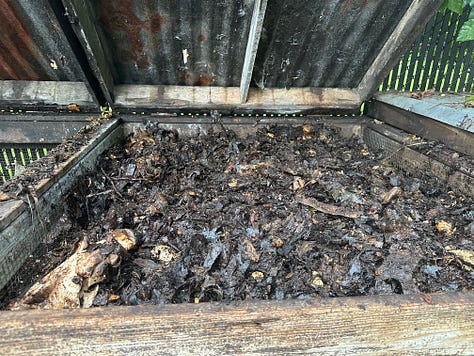

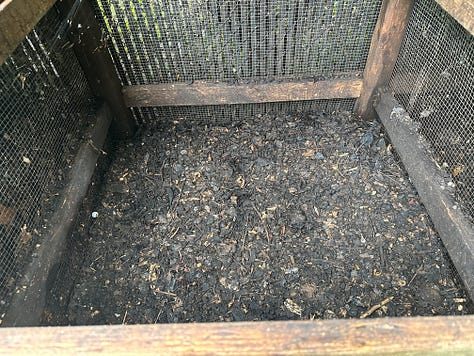
Thanks for your patience, dear reader! We’ll be back at bin 6 next week, which will be a nice reprieve. Also, if you’re interested in seeing how the bins change over time, check out the project tracker here.





